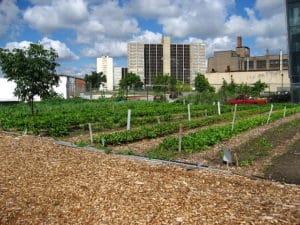City farming illuminates a different paradigm
Earth Island Journal
By Maywa Montenegro

Linda from Chicago, Wikimedia
Rene Zazueta and I had crossed paths numerous times on the UC Berkeley campus. Since he rarely uttered a word in meetings we both attended, I thought him as the “silent sidekick” of Miguel Altieri, the UC professor and agroecology researcher who was recently nominated by Michael Pollan for Mark Bittman’s “alternative World Food Prize.” But it turns out that Zazueta has a lot to say when transplanted to a vegetable patch. In his backyard on Berkeley’s Haste Street, on land that was once a parking lot, Zazueta has designed what Altieri likes to call an “agroecological lighthouse.” It is both a scientific experiment station and a community gathering ground, beckoning people to learn, take away, and pass along the knowledge of urban agroecology – that is, agriculture based in the principles of ecology.
Some environmental activists have used the metaphor of the lifeboat to explain how we can get out of our worsening environmental predicament. Business-as-usual is the Titanic, sinking fast. What we need, then, is a renewable energy powered liferaft (complete with organic rations) to rescue us. To lead the way, we need a kind of lighthouse. As Altieri sees it, urban farms and gardens based on the principles of agroecology can serve as that beacon.
Agroecology is an always-evolving learning process, linking science, practice, and social movement. Putting theory and practice on a level playing field, it departs from high modernist approaches to agricultural problem-solving, and instead seeks to plumb the locally adapted, inventive, and often improvisational techniques that farmers have honed through millennia of cultivating land. This perspective, according to a recent history of agroecology by Steven Gliessman, harks back to the writings of US tropical ecologist Daniel Janzen, who argued that production should be “grounded in local ecological knowledge, locally adapted, limited by local environments and culture, and designed to meet local needs first rather than respond to the demands of export markets for single commodity crops.” Janzen’s insights were mirrored in multiple emergences of agroecology across Central and South America in the 1970s and 80s. The Mexican ethnobotanist Efraím Hernández Xolocotzi insisted that all studies should include the full participation of farmers and their communities – especially those being rapidly marginalized by the Green Revolution.
Farmers and gardeners working in the soil have long been recognized as agroecology’s true innovators. The challenge today, as ecologist Richard Levin puts it, is how to link the “broad but shallow” knowledge of Western science with the “deep but narrow” knowledge of traditional and indigenous farmers.
Equally pressing is the shape and direction of agrocoecology as a social movement. From its roots in resistance to the Green Revolution to the ferments of transnational peasant organizations today, agroecology draws its energy from people with an explicit goal of transforming the food system. To date, these movements have mostly focused on rural societies and ecosystems. But as the number of displaced farmers worldwide continues to mount, the planet’s expanding cities are now sites for some of agroecology’s most dynamic research.
Altieri provides some daunting statistics. In just one century, the number of people living in cities has ballooned from 15 percent of total world population to more than 50 percent today. This figure is projected to climb to 69 percent by 2050 as global population rises to 9 billion. How are we to face this change, in which the number of food-eaters grows even while the number of food-makers declines? The solution favored by many is industrial intensification of the countryside. Supposedly greater use of synthetic fertilizers, improved seeds, agrochemicals, and vast monoculture will feed future cities, using less human labor. Another idea hinges on helping peasants continue to farm as they arrive in cities, and transforming long-time urban-dwellers into a new corps of urban agrarians.
Both approaches, according to Altieri, could be supported by urban agroecology. But his assertions rests on many caveats – scalability, energy efficiency, land and labor costs, to name but a few. By highlighting the productivity of Rene Zazueta’s backyard, Altieri offers an example of the kind of work necessary. With local vertical agriculture projects, urban farms, and backyard gardens one can glimpse the social relations that bridge science, practice and social movements.
After the Loma Prieta earthquake in 1989, Zazueta says, his backyard was a disaster. A carport had collapsed onto the vehicles beneath, crushing glass, chemicals, and toxic metals into the soil. Rather than rebuild the concrete lot, Zazueta invited friends to help haul away the scrap metal and contaminated dirt. After weeks of heavy work the plot was ripe for an experimental garden.
Entering Zazueta’s backyard, one finds something of a planned Mediterranean jungle. On one side, fruiting trees of all types line a fence: avocados, citrus, persimmons, plums, pears, mulberries, cherimoyas, and apples – an array chosen to bear fruit throughout the entire year. In the center, raised beds brim with leafy greens, root and cruciferous vegetables, melons, and berries, each row meticulously intercropped with beans to provide nitrogen, and flowering plants to attract beneficial insects. In the garden’s rear, peppers, herbs, potatoes, and tomatoes peep out of modular planters. These, Zazueta says, are experimental designs for pop-up vegetable gardens using low-cost materials like wood pallets, hay, and chicken wire.
Experiments run mycelium-like throughout the garden. Zazueta has rigged up a trellis of Early Girl tomatoes under the canopy of fruit trees. The tomatoes have never been watered, yet so far look none worse for the wear. Zazueta has figured out that the combination of minimal morning sun and tree shade prevents evapotranspiration to the degree that the plants never need an artificial shower. Waste is also another major concern of Zazueta’s, so he has developed a compost system that transforms every scrap of household food waste into worm food, which in turn goes to feed a world of soil microbes. To circulate this organic material throughout the garden, Zazueta brews ‘compost tea’: a mix of vermiculture castings, goat manure, blood (a protein source for soil microbes), and molasses (bacteria need their sugar). It is this unlikely cocktail that probably accounts for his vegetables’ uncommon proportions, Zazueta says, as he shakes a vine heavy with football-sized squash.
These experiments speak to why Altieri recognizes this place as a paragon for agroecology: the garden’s productivity thrives on the synergies of a biologically interconnected system. But it is the social connections fostered by, and within, the garden that elevate it from agroecology archetype to agroecology lighthouse. Such relationships begin with Zazueta, a gardener who quietly traverses the university-community boundary on a regular basis, poking at conventional wisdom about who should participate in research, where scientific knowledge is produced, and whom it should benefit.
For example, Zazueta has collaborated with UC Berkeley professor Céline Pallud on studies that have revealed that aeration is vital to control the growth of coliform bacteria in the compost tea. Without this aeration, crops fertilized with the solution would be too risky to eat right off the vine (health guidelines suggest not spraying foliage for at least 2 weeks). But this danger can be allayed for the price of a cheap aquarium pump, the researchers found. With Altieri, Zazueta’s collaborations are more social-political in bent. For the past several years, the two have been building gardens for low-income families in Berkeley, and encouraging students in Altieri’s undergraduate Urban Agriculture seminar to become involved. Teaching people how to grow food agroecologically, Altieri says, can bring reciprocal gains, as students become first-hand witnesses to the social benefits of advancing urban agriculture.
Though he is a consummate record keeper, Zazueta does not keep firm track of his crop yields. But he knows that his backyard regularly yields a bumper crop, and calculations by Altieri and others suggest that urban systems can grow food in quantities that are far from trivial. Consider Oakland, where an estimated 1,200 acres of land could feasibly be brought into production. “Assuming a productivity of 5 kilos per square meter – one quarter of Cuban productivity – we could make 25 million kilos of food,” Altieri says. “That’s enough to feed 125,000 people.”
Meanwhile, the stakes for scaling up urban food production grow ever higher, with China planning to uproot and urbanize 250 million peasants over the next 15 years. How these cities will subsist – whether via factory farming and increased food imports, or via decentralized urban agroecology – will have tremendous implications for landscapes and people, not just in China but worldwide.
It’s worth emphasizing, however, that ‘How Can We Feed The World?’ is not a question that resonates with the ethos of agroecology. Anyway, if it were the case that feeding the world was contingent on global yield, the 2,800 calories daily per person that are currently produced each year would suggest the hunger problem has been solved. This is why Zazueta, Altieri, and like-minded folks in the agroecology movement insist that production is “necessary but insufficient.”
Far more important is the rights of local people to make decisions about what they grow and eat, where, when, and how. When farmers have power over their agriculture and food policies, can organize production and consumption to meet local needs, and can secure access to land, water, and seed – that, says Altieri, would be the mark of a paradigm shift.
From where we stand today, amid supermarket aisles stuffed with corn products, such food sovereignty may seem utopian. But Zazueta and other urban famers realize sovereignty in small steps, day by day. At this scale, the overarching project often looks daunting. But there is room for levity, too. This summer, Zazueta’s immediate concern is an imbalance in the ratio of cucumbers and tomatoes in the garden. “Do you know why this is a very big problem?” he asks. “It’s because of gazpacho! If you have too many cucumbers and not enough tomatoes, you can’t make gazpacho!”

